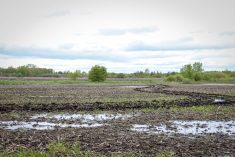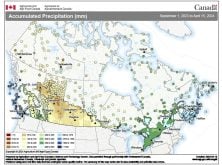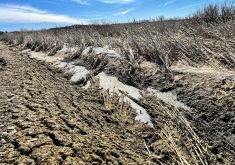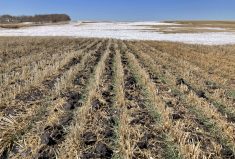After a wet growing season across most of the Prairies, one analyst predicts Western Canada will be in for a cold and dry winter.
Drew Lerner of World Weather Inc. in Kansas City said the weather phenomenon La Nińa will be in play during the upcoming winter months, meaning in general, conditions will be colder and drier than normal.
However, Lerner said, there will be a couple of exceptions.
“Over the next couple of weeks (taking us toward the end of November), precipitation will periodically be above average,” he said. “We will see above-average precipitation in the spring as well.”
Read Also

Mazergroup’s Bob Mazer dies
Mazergroup’s Bob Mazer, who helped grow his family’s company into a string of farm equipment dealerships and the main dealer for New Holland machinery in Saskatchewan and Manitoba, died July 6 from cancer.
Bruce Burnett, director of crop and weather surveillance with the Canadian Wheat Board in Winnipeg, said cold temperatures wouldn’t hurt the winter wheat crop, unless there is a lack of snow.
“We could see more winterkill if there is a lack of snow,” Burnett said. “It’s important that we don’t see any extended cold snaps before we have snow on the ground. It’s nice to have some snow covering the wheat.”
While producers are hoping for a decent amount of snow to prevent cold temperatures from affecting the crop, Burnett said it’s also critical that the Prairies don’t see too much precipitation.
“One concern on winter wheat is that the soils are still wet. We have pretty much surplus moisture in the soil,” he said. “If we get a lot of snow, there’s a chance we could see more winterkill in the spring because of ponding and standing water, and those types of things.”
Spring crops could also be in danger of being too wet if there is a surplus of snow. Stuart McMillan, also with the CWB, said a lot of winter precipitation could be very detrimental.
“One of the greatest concerns would be going through this winter and having excess snowfall, which would really hurt the crops,” he said. “It would make it more difficult for producers to get on the field in the spring.”
The last three or four weeks of dry weather have significantly reduced soil moisture levels, but he said they are still wetter than normal.
RECHARGE
The only area on the Prairies that isn’t dealing with an abundance of moisture is the Peace River region in Alberta.
Producers there will not be too pleased with the outlook for the winter, Lerner said.
“Peace River will get some precipitation, but it will be less than normal over the course of the winter,” he said.
Burnett said the real concern for producers in the Peace River area might not be right now, but rather once the winter is over.
“They need to see some additional moisture to help them recharge,” Burnett said. “This could be a real issue in the spring.”
Lerner said the mild weather conditions the Prairies have been seeing may soon come to an end, as flurries were expected this week.


















